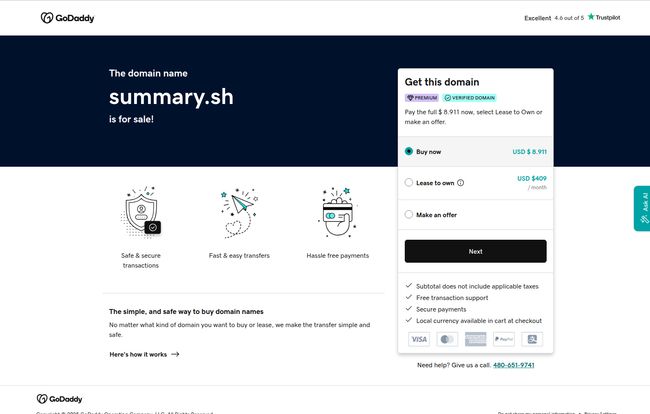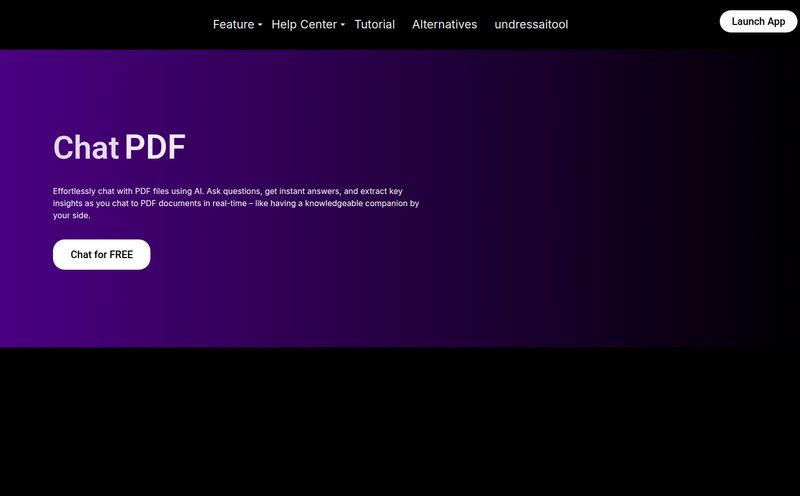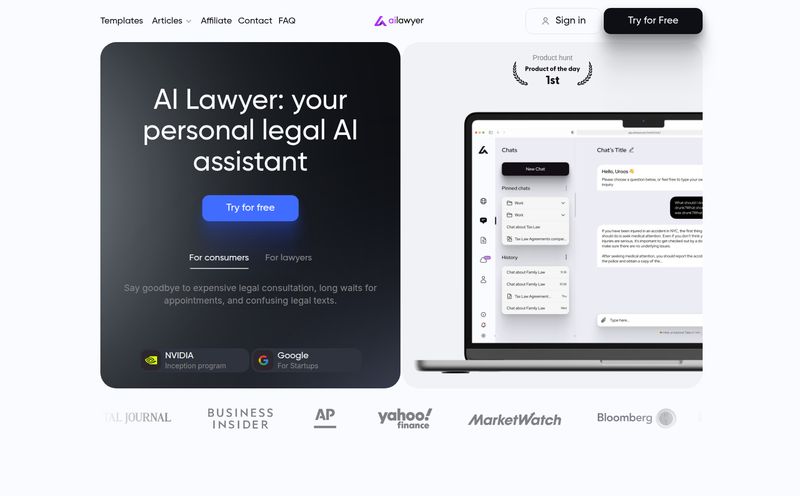You know that feeling, right? The one where your browser has 37 tabs open, your inbox is a disaster zone of newsletters and reports, and you have a folder of PDFs you swore you’d read “this weekend.” It’s the modern content marketer’s curse: information overload. We’re drowning in data, and sometimes, all we need is the gist. Just the highlights, please.
So, when a tool like Summary.sh pops up on my radar, I get genuinely excited. An all-in-one API designed to be a universal translator for long-form content? Sign me up. It promised to take almost any file format—text, PDFs, even video and audio files—and spit out a neat, tidy summary. For a guy who lives and breathes content, traffic, and trends, this sounds less like a tool and more like a lifeline. But as I started digging, the story took a… weird turn. This isn't just a review; it's a bit of a digital detective story.
What Was Summary.sh Supposed to Be?
On paper, Summary.sh was the dream. It wasn’t just another web app where you paste text into a box. It was pitched as a powerful API (Application Programming Interface). Think of it as a specialized worker you could hire to plug directly into your own systems. You could hook it into your company's internal knowledge base, your content management system (CMS), or even a customer service platform to summarize long support tickets on the fly. No need to build, train, and manage your own complex Large Language Models (LLMs). You just send the content to Summary.sh, and it sends back the summary. Simple, clean, effective.
The main selling point was its ability to handle all the messy preprocessing. You didn't need to convert a PDF to text first or transcribe a video. The API was designed to take the raw file, parse it, and do its magic. That alone is a huge time-saver. It was meant to be the content marketer's equivalent of a Cuisinart – just toss the ingredients in and get something useful out.

Visit Summary.sh
The Features That Made Me Sit Up and Pay Attention
It’s easy for new AI tools to make big promises, but the feature list for Summary.sh had some real substance. It showed a deep understanding of what users actually need.
Beyond Just Plain Text
Most summarizers I’ve seen are pretty basic. You give them text, they give you shorter text. But Summary.sh claimed support for a whole range of formats: plain text, PDFs, DOC files, and even audio and video. The potential here is massive. Imagine feeding it an hour-long webinar recording and getting back a concise, bulleted summary for your blog post. Or dropping a 50-page industry whitepaper (you know the ones, full of fluff) and getting the three key takeaways. That’s not just a convenience; it’s a competitive advantage.
The Two Flavors of Summarization
Here’s where my inner SEO nerd gets a little giddy. Summary.sh offered both extractive and abstractive summarization. What’s the difference?
Extractive summarization is like using a highlighter. The AI pulls out the most important sentences and phrases directly from the source text and stitches them together. It’s great for accuracy and sticking to the facts.
Abstractive summarization is more like how a human would do it. The AI reads and ‘understands’ the content, then generates a completely new summary in its own words. This is fantastic for creating more natural, flowing descriptions for social media or even generating meta descriptions that don't sound robotic. Having both options is like having a scalpel and a paintbrush – different tools for different jobs, and I love having the choice.
The Dream of Easy Integration
The fact that it was an API-first tool was a big green flag for me. It means the creators were thinking about workflows and systems, not just a one-off gimmick. For agencies and in-house teams, the ability to seamlessly integrate a tool like this into your existing tech stack is a game-changer. It reduces friction and makes the tool part of the process, rather than another task to manage.
So, Where Is It? The Plot Twist
So here I am, all hyped up, ready to test this thing out, maybe even recommend it to a few clients. I head over to the `summary.sh` domain and… I’m greeted by a GoDaddy landing page. The domain is for sale. For a cool $8,911, to be precise. Oof. That's a punch to the gut.
A promising tool, with a great name and a solid concept, is now just a piece of digital real estate waiting for a buyer. It’s a ghost. This happens more often than you’d think in the tech world. It’s a digital graveyard of good ideas. Maybe the funding ran out. Maybe they got acquired and the tech was absorbed into something else (an "acqui-hire"). Maybe the creators just got tired and moved on. We’ll probably never know for sure, but it’s a stark reminder of how volatile this space is.
Looking Back: Were There Red Flags?
With the benefit of hindsight, I looked back at the information I had. Were there signs of trouble? Well, maybe. The two biggest cons listed for the platform were a lack of explicit pricing and limited information on the specific AI models they were using. That's a classic startup move – keep things vague while you figure them out. But it's also a red flag for potential customers. I've always been wary of tools that hide their pricing. It suggests they either haven't figured it out or they want to charge you based on how big they think your wallet is. Neither is a great look.
| The Promise (Pros) | The Potential Problems (Cons) |
|---|---|
| Handled tons of file formats (PDF, video, etc.) | Pricing wasn't stated anywhere. Big question mark. |
| Offered both extractive and abstractive summaries. | No transparency about the AI models being used. |
| Easy API integration for custom workflows. | Limited online presence or community. A ghost ship. |
The lack of transparency around their AI models is also a bit concerning. Are they using a fine-tuned version of a known model like GPT, or something they built from scratch? For developers, that kind of detail matters.
The Need for a Tool Like This Still Exists
Even though Summary.sh appears to be gone, the problem it was trying to solve is more relevant than ever. AI-powered summarization is no longer a novelty; it’s becoming a necessity. As content creators, we need tools to help us work smarter, not harder. We need to be able to quickly digest research, repurpose long-form content into social media snippets, and provide TL;DR (Too Long; Didn't Read) versions for our busy audiences.
The dream of a universal content summarizer isn't dead. There are other players in the space, of course. But the elegant, API-first, multi-format approach of Summary.sh was genuinely compelling. It serves as a great blueprint for what the ideal tool should look like. I have no doubt someone else will crack this nut, or maybe someone will even buy that domain and resurrect the idea. I certainly hope so.
Frequently Asked Questions
What was Summary.sh?
Summary.sh was conceived as an all-in-one API for AI-powered content summarization. It was designed to parse and summarize various file types, including text, PDFs, and even video files, offering both abstractive and extractive summary types for easy integration into existing workflows.
Is Summary.sh still available?
As of late 2024, it appears not. The domain name `summary.sh` is listed for sale on GoDaddy, which strongly suggests the original project is no longer active or has been abandoned.
What is the difference between abstractive and extractive summarization?
Extractive summarization involves pulling key sentences and phrases directly from the source text to form a summary. Abstractive summarization involves the AI rephrasing the content to generate a new, unique summary, much like a human would.
Why is an API for summarization useful?
An API allows developers to build the summarization functionality directly into their own applications. For example, a media monitoring tool could use it to automatically summarize news articles, or a CMS could use it to suggest a summary for a new blog post.
Are there good alternatives to Summary.sh?
Yes, the field of AI tools is booming. While Summary.sh had a unique combination of features, there are other services and open-source models that offer powerful summarization capabilities. Researching tools that integrate with models from OpenAI, Anthropic, or Cohere can be a good starting point for similar functionality.
What could cause a promising tool like this to disappear?
It's common in the tech startup world. Reasons can range from running out of funding, the founders moving on to other projects, technical challenges that prove insurmountable, or being acquired by a larger company that shuts down the public-facing product.
A Final Thought on Digital Ghosts
The story of Summary.sh is a classic tech tale. A brilliant idea, a sleek execution plan, and a sudden, quiet disappearance. It’s a digital ghost, a reminder of what could have been. For those of us in the trenches of SEO and content, it's a bit sad to see a potentially game-changing tool vanish. But it also fuels the excitement for what's next. The need is there, the technology is getting better every day, and somewhere out there, another team is probably working on the next great summarization tool. I’ll be here, waiting to test it out. Hopefully, that one will remember to renew its domain registration.
Reference and Sources
Domain Listing: The status of the `summary.sh` domain was observed on its GoDaddy sales page.
For a deeper read on API integration, Zapier has a great non-technical explanation.



